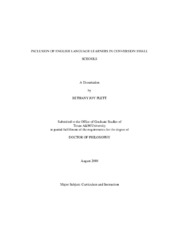| dc.contributor.advisor | Burlbaw, Lynn, M. | |
| dc.contributor.advisor | Eslami, Zohreh, R. | |
| dc.creator | Plett, Bethany Joy | |
| dc.date.accessioned | 2010-01-15T00:08:36Z | |
| dc.date.accessioned | 2010-01-16T01:07:32Z | |
| dc.date.available | 2010-01-15T00:08:36Z | |
| dc.date.available | 2010-01-16T01:07:32Z | |
| dc.date.created | 2008-08 | |
| dc.date.issued | 2009-05-15 | |
| dc.identifier.uri | https://hdl.handle.net/1969.1/ETD-TAMU-2942 | |
| dc.description.abstract | Small school reform is an increasingly popular reform in urban comprehensive
high schools. Efforts to divide large high schools into small school groups have been
funded by The Bill and Melinda Gates Foundation as well as by the Coalition of Essential
Schools (CES). The Coalition of Essential Schools is a network of small schools that
adhere to similar educational ideologies such as the desirability to provide inclusive
educational environments. CES promotes inclusion as a means to equitable and
democratic education. This study explains the tensions the philosophy and practice of
inclusion has produced concerning English language learner (ELL) programs in
conversion small schools. This study investigates (a) the ways in which ELL programs in
conversion small schools have supported inclusive education, (b) the ways small school
inclusion has affected ELL programs, and (c) the impact inclusion philosophy in
conversion small schools on inclusive and equitable instruction for ELL students.
Through a multi-case qualitative study including interviews and observations, the
contexts for the ELL programs in three different conversion schools are investigated and
described. The data shows that none of the ELL programs investigated have been able to
fully support instructional inclusion either due to a lack of belief in the efficacy of inclusion or a lack of resources. Small school inclusion has affected ELL programs
differently in each school. At one school, the ELL program felt almost no effects of the
conversion. At another, the program is radically different than previous to the conversion.
Third, inclusive and equitable instruction for ELL students in conversion small schools,
even in the best case, is happening only in some classes. Due to a lack of resources, no
ELL program has been able to implement inclusion as a programmatic reform. Finally,
the impetus to involve ELL students in inclusion programs is highly influenced by special
education policies rather than by legislation overseeing ELLs. The study concludes that
inclusion is understood and practiced differently at each site. At the sites where any type
of inclusion was practiced, teachers reported that inclusion provided ELL students with
more social than academic benefits. | en |
| dc.format.medium | electronic | en |
| dc.format.mimetype | application/pdf | |
| dc.language.iso | en_US | |
| dc.subject | ELL | en |
| dc.subject | Inclusion | en |
| dc.subject | Small Schools | en |
| dc.title | Inclusion of English language learners in conversion small schools | en |
| dc.type | Book | en |
| dc.type | Thesis | en |
| thesis.degree.department | Teaching, Learning, and Culture | en |
| thesis.degree.discipline | Curriculum and Instruction | en |
| thesis.degree.grantor | Texas A&M University | en |
| thesis.degree.name | Doctor of Philosophy | en |
| thesis.degree.level | Doctoral | en |
| dc.contributor.committeeMember | Clark, M. Carolyn | |
| dc.contributor.committeeMember | Sandlin, Jennifer | |
| dc.type.genre | Electronic Dissertation | en |
| dc.type.material | text | en |
| dc.format.digitalOrigin | born digital | en |


